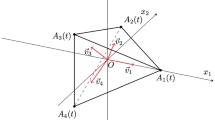Abstract
In this article we deal with the variational approach to cactus trees (Husimi trees) and the more common recursive approach, that are in principle equivalent for finite systems. We discuss in detail the conditions under which the two methods are equivalent also in the analysis of infinite (self-similar) cactus trees, usually investigated to the purpose of approximating ordinary lattice systems. Such issue is hardly ever considered in the literature. We show (on significant test models) that the phase diagram and the thermodynamic quantities computed by the variational method, when they deviates from the exact bulk properties of the cactus system, generally provide a better approximation to the behavior of a corresponding ordinary system. Generalizing a property proved by Kikuchi, we also show that the numerical algorithm usually employed to perform the free energy minimization in the variational approach is always convergent.
Similar content being viewed by others
REFERENCES
D. A. Lavis and G. M. Bell, Statistical Mechanics of Lattice Systems, Vol. 1 (Closed Form and Exact Solutions) (Springer-Verlag, Berlin/Heidelberg/New York, 1999).
T. Morita, Physica A 105:620(1981).
R. B. Griffiths and M. Kaufman, Phys. Rev. B 26:5022(1982).
P. D. Gujrati, Phys. Rev. Lett. 74:809(1995).
J. L. Monroe, J. Stat. Phys. 65:255(1991).
J. L. Monroe, J. Stat. Phys. 67:1185(1992).
J. L. Monroe, Physica A 206:218(1994).
J. L. Monroe, Physica A 256:217(1998).
N. S. Ananikian, R. G. Ghulghazaryan, and V. S. Izmailian, Int. J. Mod. Phys. B 12:2349(1998).
N. S. Ananikian et al., Phys. Lett. A 248:381(1998).
C. S. O. Yokoi, M. J. de Oliveira, and S. R. Salinas, Phys. Rev. Lett. 54:163(1985).
I. Ono, Prog. Theor. Phys. Supp. 87:102(1986).
P. Chandra and B. Doucot, J. Phys. A 27:1541(1994).
H. Rieger and T. R. Kirkpatrick, Phys. Rev. B 45:9772(1992).
T. Morita, J. Phys. A: Math. Gen. 9:169(1976).
J. F. Stilck and M. J. de Oliveira, Phys. Rev. A 42:5955(1990).
J. F. Stilck and J. C. Wheeler, Physica A 190:24(1992).
A. J. Banchio and P. Serra, Phys. Rev. E 51:2213(1995).
J. F. Stilck, K. D. Machado, and P. Serra, Phys. Rev. Lett. 76:2734(1996).
V. V. Papoyan and R. R. Scherbakov, J. Phys. A 28:6099(1995), V. V. Papoyan and R. R. Scherbakov Fractals 4:105 (1996).
F. Mejia-Lira, K. H. Bennemann, and J. L. Moran-Lopez, Phys. Rev. B 26:5398(1982).
M. F. Thorpe, D. Weaire, and R. Alben, Phys. Rev. B 7:3777(1973).
C. J. Thompson, Phys. Lett. A 47:23(1974).
D. M. Burley, in Phase Transitions and Critical Phenomena, Vol. 2, C. Domb and M. S. Green (Eds.), (Academic Press, New York, 1972).
A. Pelizzola and M. Pretti, Phys. Rev. B 60:10134(1999).
J. L. Monroe, Phys. Rev. E 64:16126(2001).
J. A. de Miranda-Neto and F. Moraes, J. Phys. I France 2:1657(1992), J. A. de Miranda-Neto and F. Moraes, J. Phys. I France 3:29 (1993).
J. L. Monroe, Phys. Lett. A 188:80(1994).
R. Kikuchi, J. Chem. Phys. 60:1071(1974).
M. Kurata, R. Kikuchi, and E. Watari, J. Chem. Phys. 21:434(1953); C. Domb, Adv. Phys. 9:823 (1960).
G. An, J. Stat. Phys. 52:727(1988).
C. Gruber, A. Hintermann, and D. Merlini, Group Analysis of Classical Lattice Systems (Springer-Verlag, Berlin, 1977), p. 25.
B. D. Metcalf, Phys. Lett. A 45:1(1973).
P. Bak and J. von Boehm, Phys. Rev. B 21:5297(1980).
Author information
Authors and Affiliations
Rights and permissions
About this article
Cite this article
Pretti, M. A Note on Cactus Trees: Variational vs. Recursive Approach. Journal of Statistical Physics 111, 993–1015 (2003). https://doi.org/10.1023/A:1022862618478
Issue Date:
DOI: https://doi.org/10.1023/A:1022862618478




